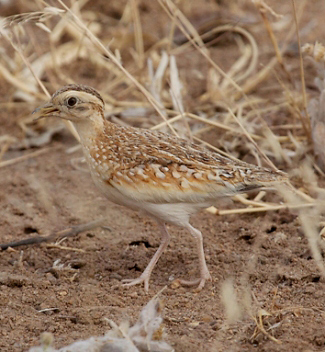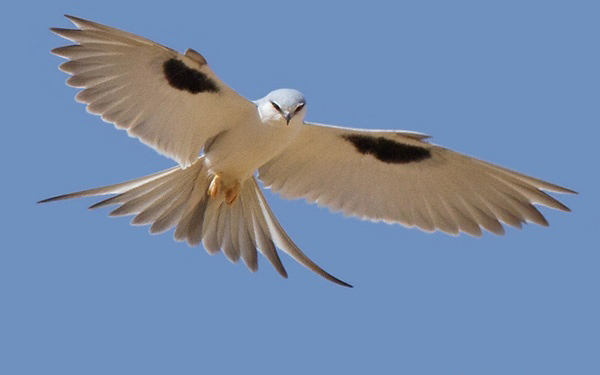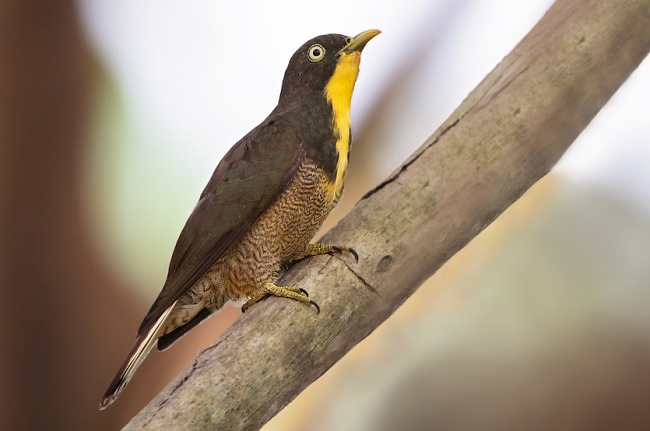

Cameroon is one of the few places where it is possible to see the strange Quail Plover. This one was photographed there by Simon Colenutt.
- The richest birdlife in West Africa
- With five endemics including Bannerman’s Turaco and Banded Wattle-eye
- And many West African specialities such as Grey-necked Rockfowl, Grey Pratincole, Grey-headed and Rufous-sided Broadbills, and Green-breasted and Mount Kupe Bushshrikes
- And more widespread spectacular African species including Black Crowned Crane, hornbills, African Swallow-tailed Kite, Egyptian Plover, African Skimmer, and Abyssinian and Blue-bellied Rollers, with a chance of Quail Plover
- Plus a wide variety of monkeys and other wildlife
- All in a country which extends from the semi-desert of the Sahel in the north to the montane forests and lowland rainforests in the south
- In January 2020 the British Foreign and Commonwealth Office (FCO) continued to advise against all travel to: Far North region; within 40km of the border with Nigeria; within 40km of the border with Chad; within 40km of the border with the Central African Republic (CAR); the Bakassi Peninsula; the South West Region; and the North West Region. It also advised against all but essential travel to: Limbe in Fako division, South West region; and the rest of North and Adamawa regions, including Garoua in North region.
- Cameroon is a main gateway to the Central African Republic where it is possible to see 'Lowland' Gorilla, as well as Agile Mangabey, and other monkeys, African (Forest) Elephant, African (Forest) Buffalo, Red River Hog and birds which include Grey-headed Rockfowl and Plumed Guineafowl, all in some superb lowland rainforest with wet, open areas known as bais. From Cameroon it is also possible to reach Odzala-Kokoua National Park in the Republic of Congo where there are several habituated groups of 'Lowland' Gorillas which can be tracked out of Lango Camp overlooking Lango Bai, and Ngaga Camp, just outside the park.

The superb African Swallow-tailed Kite at Mora in Cameroon by Lars Petersson.
Best Birds and other wildlife in Cameroon
Birds
Endemics 5
Mount Cameroon Francolin, Bannerman’s Turaco, Banded Wattle-eye, Mount Cameroon Speirops and Bates's Weaver.
Near-endemics
Cameroon and Nigeria 13 Cameroon Olive-pigeon, Green-breasted Bushshrike, Mount Kupe Bushshrike, Yellow-breasted Boubou, Bamenda Apalis, Bangwa Warbler, Cameroon Mountain Greenbul, Grey-headed Greenbul, White-throated Mountain-babbler, Mountain Robin-chat, Bannerman’s Weaver, Rock Firefinch and Jos Plateau Indigobird.
Cameroon, Nigeria and Bioko (island in Gulf of Guinea) 9 Tullberg’s Woodpecker, Johnston’s (Elliot’s) Woodpecker, Western Mountain Sooty Boubou, Green Longtail, White-tailed Warbler, Western Mountain Greenbul, Cameroon Olive Greenbul, Cameroon Sunbird and Shelley’s Oliveback.
Cameroon, Nigeria, Bioko and Equatorial Guinea 1 Black-capped Woodland-warbler.
Cameroon, Nigeria, Equatorial Guinea and Gabon 2 Forest Swallow and Rachel’s Malimbe.
Cameroon, Nigeria and Angola 1 Fernando Po (Bioko) Swift.
Cameroon and Bioko (island in Gulf of Guinea) 2 Mountain Saw-wing and Ursula’s Sunbird.
Cameroon, Gabon and Centra African Republic (CAR) 1 Dja River Swamp-warbler.
Cameroon and Angola 1 Monteiro’s Bushshrike.
Cameroon, Angola, CAR, Republic of the Congo (RC) & Democratic Republic of the Congo (DRC) 1 Bob-tailed Weaver.
Cameroon and Chad 1 Chad (Reichenow’s) Firefinch.
Other specialities
Olive Ibis, Quail Plover, Egyptian Plover, Grey Pratincole, Adamawa Turtle-dove, Yellow-throated Cuckoo, Pennant-winged and Standard-winged Nightjars,
Bare-cheeked Trogon, Chocolate-backed Kingfisher, Black Bee-eater, Grey-headed and Rufous-sided Broadbills, Grey-necked Rockfowl (Red-headed Picathartes),
Spotted Illadopsis (Thrush Babbler) and Crossley's Ground-thrush. Also a chance of Black Guineafowl, Long-tailed Hawk, Congo Serpent-eagle, Arabian and
Savile’s Bustards, Brown-chested Lapwing, Vermiculated Fishing-owl, Fraser’s Eagle-owl, Sjostedt’s Owlet, Golden Nightjar and African Spotted Creeper.
Others
Hartlaub’s Duck, francolins, African Swallow-tailed Kite, Grasshopper and Red-necked Buzzards, Black Crowned Crane, African Skimmer, Four-banded
Sandgrouse, Afep and Western Bronze-naped Pigeons, Grey Parrot, Red-headed Lovebird, White-crested and Yellow-billed Turacos, cuckoos, Bar-tailed and
Narina’s Trogons, kingfishers, bee-eaters, Abyssinian, Blue-bellied and Blue-throated Rollers, woodhoopoes, hornbills including White-crested, barbets,
woodpeckers, Blue Cuckooshrike, Chestnut, White-spotted and Yellow-bellied Wattle-eyes, Senegal Batis, Black-headed Gonolek, shrikes including Emin’s,
Bates’s and Red-bellied Paradise-flycatchers, Piapiac, swallows including White-throated Blue, Forest and Sennar Penduline-tits, greenbuls, Oriole Warbler
(Moho), Cricket Warbler, Banded and River Prinias, Tit Hylia, Vanga Flycatcher, Heuglin’s Wheatear, Black Scrub-robin, robin-chats, alethes, akalats,
starlings including Chestnut-bellied and White-collared, sunbirds, Oriole Finch, Sudan Golden Sparrow, malimbes, weavers, firefinches, pytilias,
Dybowski’s Twinspot and Exclamatory Paradise-whydah. Also a chance of White-spotted Flufftail and Pel's Fishing-owl.
Mammals
Giraffe, Hippo, Roan, Topi, Red-fronted Gazelle, and Guereza Colobus, Preuss’s Red Colobus, Crowned, Red-capped Mangabey, Mona, Northern Talapoin, Patas,
Putty-nosed and Red-tailed Monkeys. Also a chance of African Elephant, Lion and Sand Fox, and an outside chance of Drill.
Reptiles
Nile Crocodile.

The rarely-seen Yellow-throated Cuckoo by Dubi Shapiro.
Best Sites for Birds and other wildlife in Cameroon
- Sanaga River at Edea near Douala Hartlaub’s Duck, African Pygmy Goose, African Finfoot, White-crowned Lapwing, Grey Pratincole, African Skimmer, Orange Weaver and Black-bellied Seedcracker.
- Edea to Campo Ma’an NP Long-tailed Hawk, Rock Pratincole, Grey Parrot, Bates’s Swift, Chocolate-backed Kingfisher, White-crested Hornbill, White-spotted Wattle-eye and Northern Talapoin Monkey. Also a chance of Congo Serpent-eagle.
- Campo Ma’an NP Olive Ibis, Yellow-throated Cuckoo and Rockfowl, as well as Afep and Western Bronze-naped Pigeons, Blue-headed Wood-dove, Black Bee-eater, Blue-throated Roller, Black-casqued, Piping, Red-billed Dwarf and White-thighed Hornbills, Grey and Red-fronted Parrots, White-spotted and Yellow-bellied Wattle-eyes, Blue Cuckooshrike, Blue-headed Crested-flycatcher, Forest Penduline-tit, Yellow-lored Bristlebill, Eastern Bearded Greenbul, Chestnut-capped Flycatcher, Violet-backed Hyliota, Fraser’s Sunbird, Yellow-mantled Weaver, and Blue-billed (Gray’s), Cassin’s, Crested, Rachel’s and Red-headed Malimbes.
- Mount Cameroon Mountain Saw-wing, Mount Cameroon Speirops and Mountain Robin-chat, as well as Scaly Francolin, Cameroon Olive Pigeon, Yellow-billed Turaco, Mountain Sooty and Yellow-breasted Boubous, Cameroon Mountain and Western Mountain Greenbuls, Green Longtail, Grey-chested Babbler, Waller’s Starling, Cameroon Sunbird, Black-billed and Brown-capped Weavers, Shelley’s Oliveback, Red-faced Crimsonwing and Oriole Finch.
- Korup NP Bare-cheeked Trogon, kingfishers, hornbills, greenbuls, Grey-necked Rockfowl, Rachel’s Malimbe and Red-headed (Woodhouse’s) Antpecker. Also a chance of Black Guineafowl, Long-tailed Hawk, Vermiculated Fishing-owl and Sjöstedt’s Owlet.
- Mount Kupe and Bakossi Mountains Green-breasted, Fiery-breasted and Mount Kupe Bushshrikes, Black-capped Woodland-warbler, White-tailed Warbler, Grey-chested Babbler, White-throated Mountain-babbler, Crossley’s Ground-thrush and Ursula’s Sunbird, as well as Cameroon Olive-pigeon, Chattering Yellowbill, African Emerald Cuckoo, Bar-tailed Trogon, Black Bee-eater, Grey-headed Broadbill, Fernando Po Batis, Bates’s Paradise-flycatcher, Cameroon Olive, Grey-headed and Western Mountain Greenbuls, Yellow-footed Flycatcher, Cameroon Sunbird, Shelley’s Oliveback and Red-headed (Woodhouse’s) Antpecker.
- Lake Awing, Bamenda Highlands Bannerman’s Turaco, Banded Wattle-eye, Mountain Robin-chat and Bannerman's Weaver, as well as Yellow-breasted Boubou, White-bellied Tit, Cameroon Mountain, Cameroon Olive and Western Mountain Greenbuls, Bamenda and Black-collared Apalises, Green Longtail, Neumann's Starling, Cameroon and Orange-tufted Sunbirds, and Grey-headed Oliveback.
- Ngaoundaba Ranch, Adamawa Plateau Spotted Illadopsis, Grey-winged Robin-chat and White-collared Starling, as well as Hartlaub’s Duck, White-spotted Flufftail, Red-headed Lovebird, White-crested Turaco, Sun Lark, Bamenda Apalis, Gambaga Flycatcher, and Brown and Dybowski’s Twinspots. Also a chance of Schlegel’s Francolin, Brown-chested Lapwing, and Pennant-winged and Standard-winged Nightjars.
- Benoue NP White-throated Francolin, Egyptian Plover, Adamawa Turtle-dove and Bannerman's Pipit, as well as Stone Partridge, Pennant-winged and Standard-winged Nightjars, Red-throated Bee-eater, Abyssinian and Blue-bellied Rollers, Oriole Warbler, African Spotted Creeper, Bronze-tailed Starling, White-cheeked Oliveback, Giraffe, Hippo, (Buffon’s) Kob, Western Hartebeest and Giant Eland. Also a chance of Pel’s Fishing-owl.
- Poli Heuglin’s Wheatear, White-fronted Black-chat and Brown-rumped Bunting.
- Garoua area A chance of Chad Firefinch.
- Maroua to Waza NP Clapperton’s Francolin, African Swallow-tailed Kite, Arabian Bustard, Black Scrub-robin, Heuglin’s Wheatear and Golden-breasted Bunting.
- Waza NP Clapperton's Francolin, Black Crowned Crane, Quail Plover (near Mora), Sennar Penduline-tit, Red-pate Cisticola, Cricket Warbler, River Prinia, Black Scrub-robin, Chestnut-bellied Starling, Sudan Golden Sparrow, Giraffe, Roan, Topi and Patas Monkey. Also a chance of Arabian and Savile’s Bustards, Golden Nightjar and African Elephant.
- The best website for trip reports is CloudBirders
- but these are also worth a look
- Birdtours
- Fatbirder
- Jon Hornbuckle
- Mammal Watching
Best Times for Birds and other wildlife in Cameroon
February-March, when many of the resident bird species are at their most active and attractive, at the beginning of their breeding seasons, before the heavy rains of the wet season which usually lasts from May to August, is the peak time to visit Cameroon. Many bird migrants from the north are also still present in the far north during February and March.
Recommended Bird Books etc. for Cameroon
Birds of Western Africa by N Borrow and R Demey. Helm, 2014 (Second Edition (paperback)).
Birds of Western Africa by N Borrow and R Demey. Helm, 2002 (First Edition (hardback)).
Birds of Africa south of the Sahara by I Sinclair and P Ryan. C Struik, 2011 (Second Edition).
The Kingdon Field Guide to African Mammals by J Kingdon. Bloomsbury, 2015 (Second Revised Edition).
The Kingdon Pocket Guide to African Mammals by J Kingdon. Bloomsbury, 2016 (Second Edition).
Primates of West Africa by John F Oates. Conservation International, 2011.
Apps etc.
The Kingdon Guide to African Mammals.
Where to watch birds in Africa by N Wheatley. Helm, 1995.
Don’t know which country/countries to visit in Africa? Then it may be worth considering taking a look at this book, written by this website’s author. It is many years old of course but it still provides a starting point, an overview and a guiding light to the best birds and the best places to look for them on the continent, and could save hours of searching for similar information on the internet. However, it is important to check more up-to-date sources for sites which have been opened up, sites and species which have been discovered, lodges that have been built etc. since the book was published.
Birding and Wildlife Trip Reports for Cameroon
Many trip reports, some for Cameroon, are posted on the websites listed here. On some of these websites some reports are independent and some are posted by tour companies who organize tours to Cameroon. These tour companies and others also post their own reports on their websites, which are listed under 'Some Organized Tours to Cameroon' below.
Local bird and wildlife guides in Cameroon
The costs of organized tours partly reflect the quality of the tour leaders. Some leaders are certainly better than others and many companies claim their leaders are the best but even the best rely at least to some extent on the exceptional skills of the local guides they employ. If you are travelling independently, employing such local guides will greatly increase your chances of seeing the wildlife you wish to see.
Accommodation for birders in Cameroon
Some Organized Tours for birds and other wildlife to Cameroon
There are many tour companies who organize tours to see mammals, birds, other wildlife and other natural wonders. The cost of these tours vary considerably according to such variables as the airlines used, the number of days the tours last, the number of sites visited, the number of people in the group (an important consideration if you wish to see such wildlife as rainforest mammals and birds), the number of tour leaders, the standard of accommodation and transport, and the percentage profit the company hopes to make. Generally, where the number of days tours last and the number of sites visited are similar, the cheapest tours are those that use the cheapest airlines, accommodation and local transport, that have the largest groups with the least number of leaders, and that make the least amount of profit. The most expensive tours tend to be those which are exceptionally long, use the most expensive accommodation (ridiculously lavish in some cases, even for single nights) and which make the most profit. Some tour costs partly reflect the quality of the tour leaders. Some leaders are certainly better than others and many companies claim their leaders are the best but even the best rely at least to some extent on the exceptional skills of the local guides they employ.
While tour companies organize tours with set itineraries many also organize custom tours for individuals and private groups who instead of taking a tour with a set itinerary want to follow their own itinerary to suit their own personal tastes, whether it be mammals, birds, other wildlife, other natural wonders or even man-made attractions, or a mixture of them all. Many organized tours with set itineraries are also fast-paced and target as many species as possible, whether they are mammals, birds or other wildlife or everything, which usually leaves little time to enjoy the best sites and individual species, but on a custom tour those taking part can specify the pace and the sites and species they wish to concentrate on. Custom tours also suit people who like to travel with people they already know, rather than with a group of strangers, and people with partners with different interests. Individuals and small groups will almost certainly have to pay more than the price of an organized tour with a set itinerary but a large group of friends may be able to travel for less than the price quoted for a set tour.
Tour companies who run organized tours or can arrange custom tours to Cameroon include the following.
